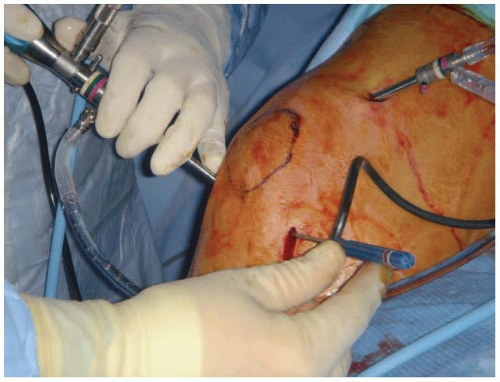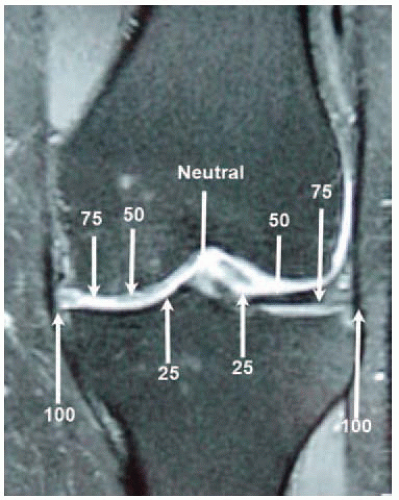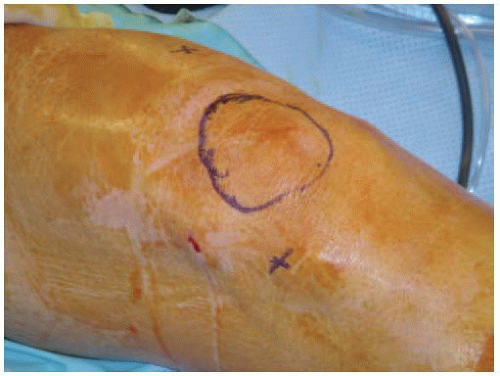Microfracture Technique: Treatment of Full-Thickness Chondral Lesions
J. Richard Steadman
William G. Rodkey
The “microfracture” technique was developed to enhance chondral resurfacing by providing a suitable environment for new tissue formation and to take advantage of the body’s own healing potential. Specially designed awls are used to make multiple perforations, or “microfractures,” into the subchondral bone plate. Microfracture is our preferred method to treat chondral defects. The senior author (JRS) first described this technique more than 20 years ago. He has treated more than 3,000 patients with the microfracture procedure.
INDICATIONS/CONTRAINDICATIONS
Indications
Microfracture was designed initially for patients with posttraumatic articular cartilage lesions of the knee that had progressed to full-thickness chondral defects. The microfracture technique still is most commonly indicated for full-thickness loss of articular cartilage in either a weight-bearing area between the femur and tibia or in an area of contact between the patella and trochlear groove. Unstable cartilage that overlies the subchondral bone is also an indication for microfracture. If a partial thickness lesion is probed and the cartilage simply scrapes off down to bone, we consider this to be a full-thickness lesion. Degenerative joint disease in a knee that has proper axial alignment is another common indication for microfracture. These lesions all involve loss of articular cartilage at the bone-cartilage interface.
Patients with acute chondral injuries are treated as soon as practical after the diagnosis is made, especially if the knee is being treated concurrently for meniscus or anterior cruciate ligament (ACL) pathology. Patients with chronic or degenerative chondral lesions often are treated nonoperatively (conservatively) for at least 12 weeks after a suspected chondral lesion is diagnosed clinically. This treatment regimen includes activity modification, physical therapy, nonsteroidal anti-inflammatory drugs, viscosupplement injections, and perhaps dietary supplements that may have cartilage-stimulating properties. If nonoperative treatment is not successful, then surgical treatment is considered.
No limitations are placed on how large an acute lesion can be and still be considered suitable for microfracture. We have observed that even very large acute lesions respond well to microfracture. We
have noted empirically that traumatic lesions, acute or chronic, less than 400 mm2 tend to respond better to microfracture than those lesions greater than 400 mm2, but we have not observed this difference to be statistically significant. Treatment of chronic degenerative lesions is not specifically limited by size, but more emphasis is placed on proper axial alignment and the presence of global degenerative changes throughout the knee.
have noted empirically that traumatic lesions, acute or chronic, less than 400 mm2 tend to respond better to microfracture than those lesions greater than 400 mm2, but we have not observed this difference to be statistically significant. Treatment of chronic degenerative lesions is not specifically limited by size, but more emphasis is placed on proper axial alignment and the presence of global degenerative changes throughout the knee.
General considerations for use of the microfracture procedure include patient age, acceptable biomechanical alignment of the knee, the patient’s activity level, and the patient’s expectations. If all of these criteria define a patient who could benefit from chondral resurfacing, then microfracture is considered.
Contraindications
Specific contraindications for microfracture include axial malalignment (as described following), patients unwilling or unable to follow the required strict and rigorous rehabilitation protocol, partial thickness defects, and inability to use the opposite leg for weight bearing during the minimal or non-weight-bearing time. Other specific contraindications include any systemic immune-mediated disease, disease-induced arthritis, or cartilage disease. A relative contraindication is for patients older than 65 years because the authors have observed that some patients older than 65 years experience difficulty with crutch walking and the required rigorous rehabilitation. Other contraindications to microfracture include global degenerative osteoarthrosis or if the cartilage surrounding the lesion is too thin to establish a perpendicular rim to hold the marrow clot. In these advanced degenerative cases, axial malalignment is often a confounding factor (Table 27-1).
PREOPERATIVE PLANNING
Patients who present with knee pain undergo a thorough physical and orthopaedic examination. The cartilage lesions can be on the joint surfaces of the femur, tibia, and/or patella. At times the physical diagnosis can be difficult and elusive, especially if only an isolated chondral defect is present. Identification of point tenderness over a femoral condyle or tibial plateau is a useful finding, but in itself is not diagnostic. If compression of the patella elicits pain, this finding might be indicative of a patellar or trochlear lesion.
For diagnostic imaging, we use long-standing radiographs as described following to observe for angular deformity and for joint space narrowing that is often indicative of loss of articular cartilage. We also obtain standard anteroposterior (AP) and lateral radiographs of both knees as well weightbearing views with the knees flexed to 30 to 45 degrees. Patellar views are also useful to evaluate the patellofemoral joint. Magnetic resonance imaging (MRI) that employs newer diagnostic sequences specific for articular cartilage has become a mainstay of our diagnostic workup of patients with suspected chondral lesions.
Two methods for radiographic measurement of the biomechanical alignment of the weight-bearing axis of the knee are used in our facility: (a) the angle made between the femur and tibia on AP views obtained with the patient standing, and (b) the weight-bearing mechanical axis drawn from the center of the femoral head to the center of the tibiotarsal joint on long standing (approx. 51 in/130 cm) radiographs. If the angle drawn between the tibia and femur is greater than 5 degrees of varus or valgus compared to the normal knee, this amount of axial malalignment would be a relative contraindication for microfracture. Preferably the mechanical axis weight-bearing line should be in the central quarter of the tibial plateau of either the medial or lateral compartment. If the mechanical axis weight-bearing line falls outside the central-most quarter of the plateaus, medial or lateral, this weight-bearing shift also would be a relative contraindication if left uncorrected (Fig. 27-1). In such cases, a realignment procedure should be included as a part of the overall treatment regimen.
TABLE 27-1. Indications and Contraindications for Microfracture | ||||||||||
|---|---|---|---|---|---|---|---|---|---|---|
|
TECHNIQUE
The patient is placed supine, and routine skin preparation and draping are completed. Standard arthroscopic portals can be used for microfracture; however, we find that making the portals slightly higher and slightly further off the midline may provide additional visualization (Fig. 27-2). We make three portals: a superior and medially placed inflow portal and medial and lateral parapatellar portals (Fig. 27-3). Accessory portals may occasionally be made for lesions in difficult-to-reach locations. Typically we do not use a tourniquet during the microfracture procedure; instead, we adjust the arthroscopic fluid pump pressure to control bleeding. An initial thorough diagnostic examination of the knee should be done before beginning the actual microfracture. We carefully inspect all geographic areas of the knee including the suprapatellar pouch, the medial and lateral gutters, the patellofemoral joint, the intercondylar notch and its contents, and the medial and lateral compartments including the posterior horns of both menisci. We do all other intra-articular procedures before completing microfracture, with the exception of ACL reconstruction. This sequence helps prevent loss of visualization when the fat droplets and blood enter the knee from the marrow cavity via microfracture holes. This technique also decreases the amount of time that the microfractured bone is exposed to the elevated intra-articular pressures and fluid flow that possibly could decrease the formation of the surgically induced marrow clot (“super clot”) that is critical to the success of the microfracture procedure. We pay particular attention to soft tissues such as plicae and the lateral retinaculum that potentially could produce increased compression between cartilage surfaces.
 FIGURE 27-3 We make three portals: a superior and medially placed inflow portal and medial and lateral parapatellar portals. |
After carefully assessing the full-thickness articular cartilage lesion, we debride the exposed bone of all remaining unstable cartilage using a hand-held curved curette and a full radius resector. It is critical to remove all loose or marginally attached cartilage from the surrounding rim of the lesion (Fig. 27-4). Establishment of a stable full-thickness border of cartilage surrounding a central lesion is optimal for microfracture to provide some degree of protection to the regenerating tissue that is forming in the treated lesion. The calcified cartilage layer that remains as a cap to many lesions must be removed, preferably by using a curette (see Fig. 27-4




Stay updated, free articles. Join our Telegram channel

Full access? Get Clinical Tree










